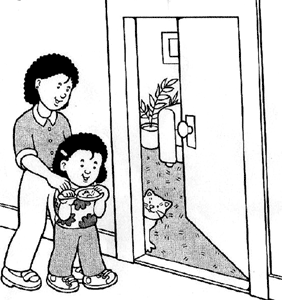
|
Fun Time
Purpose. To demonstrate the sticking power of a fly's wet feet.
Materials. Pencil, 2 inch (5 cm) square piece of copy paper, scissors, saucer, water.
Procedure.
- Fold the paper in half.
- Use the pattern shown to draw half of an insect on the paper.
- Cut out the insect, cutting through both layers of paper.
- Open the paper, bend the legs down, then bend the end of the paper legs to form the insect's "feet."
- Wet the feet with water.
- Hold a saucer upright and touch the wet feet to the saucer's outside bottom.
- Release the paper.
Results.
The paper feet should stick to the saucer. Thus, the insect hangs upside down from the saucer.
Why?
The water on the feet of the paper insect, like the moisture on a fly's feet, wets the surface, causing the water on the feet and the surface to stick together.
This experiment was taken from Janice VanCleave's Insects and Spiders and used by permission of the publisher, John Wiley & Sons, Inc.
For more information about insects, check out Janice VanCleave's Play and Find Out About Bugs (ages 4-7) and Janice VanCleave's A+ Projects in Biology (ages 13 and up).
|
Q: How do flies stand upside down on the ceiling?
A: Flies have hairy, sticky feet which make them able to walk upside down on the ceiling. Their special feet also help them to land on smooth surfaces and not slide off.
There are more than 100,000 different species of flies, including the common housefly and mosquito. They are found everywhere in the world - even on the icy land of Antarctica.
Most insects have four wings, but flies only have two. Thus they belong to the insect order called Diptera which means "two wings." Instead of a second pair of wings, flies have two small knobs called halteres that are located behind their main wings. These knobs help keep flies steady and balanced when they fly and make them very agile. Flies can move in intricate flight patterns, hover and spin, and even fly backwards.
Like all insects, flies have six legs and segmented bodies consisting of a head, a thorax and an abdomen. They have a sucking mouth part, which is a tube called a proboscis. A fly soaks up liquids with the spongy tip of its proboscis, then sucks the liquids into its body. You could eat like a fly by dipping the edge of a cookie into a glass of milk. Then place the wet end of the cookie in your mouth and suck the milk from it.
You cannot walk on the ceiling like a fly, but you can see how the world looks if you could. Here's how:
- Stand holding the edge of a mirror under your chin as shown.
- With someone guiding you so that you do not bump into things, walk through the house.
- As you walk around, look only down into the mirror. Walk through open doorways and under ceiling fans. How does your house look upside down?